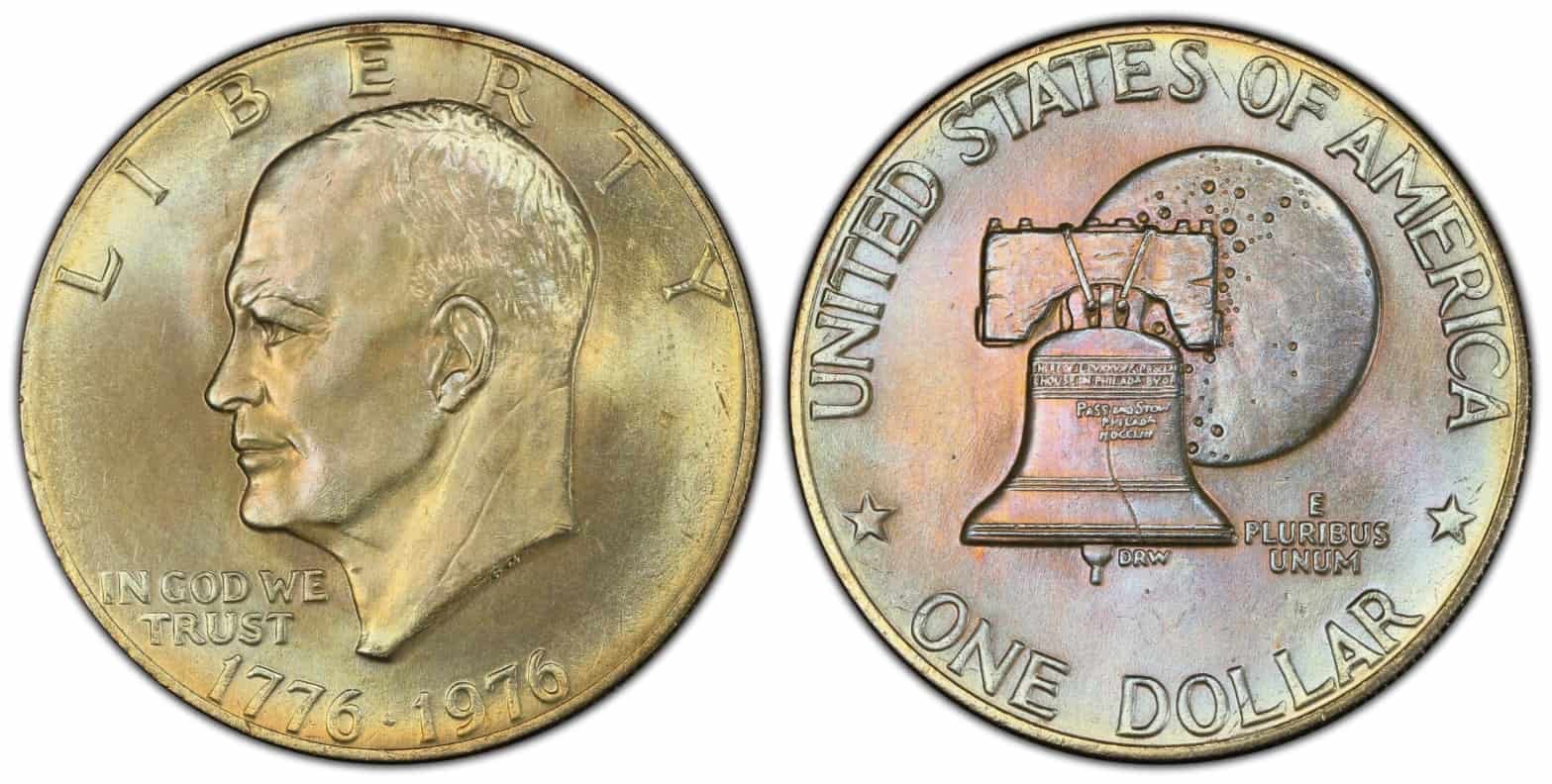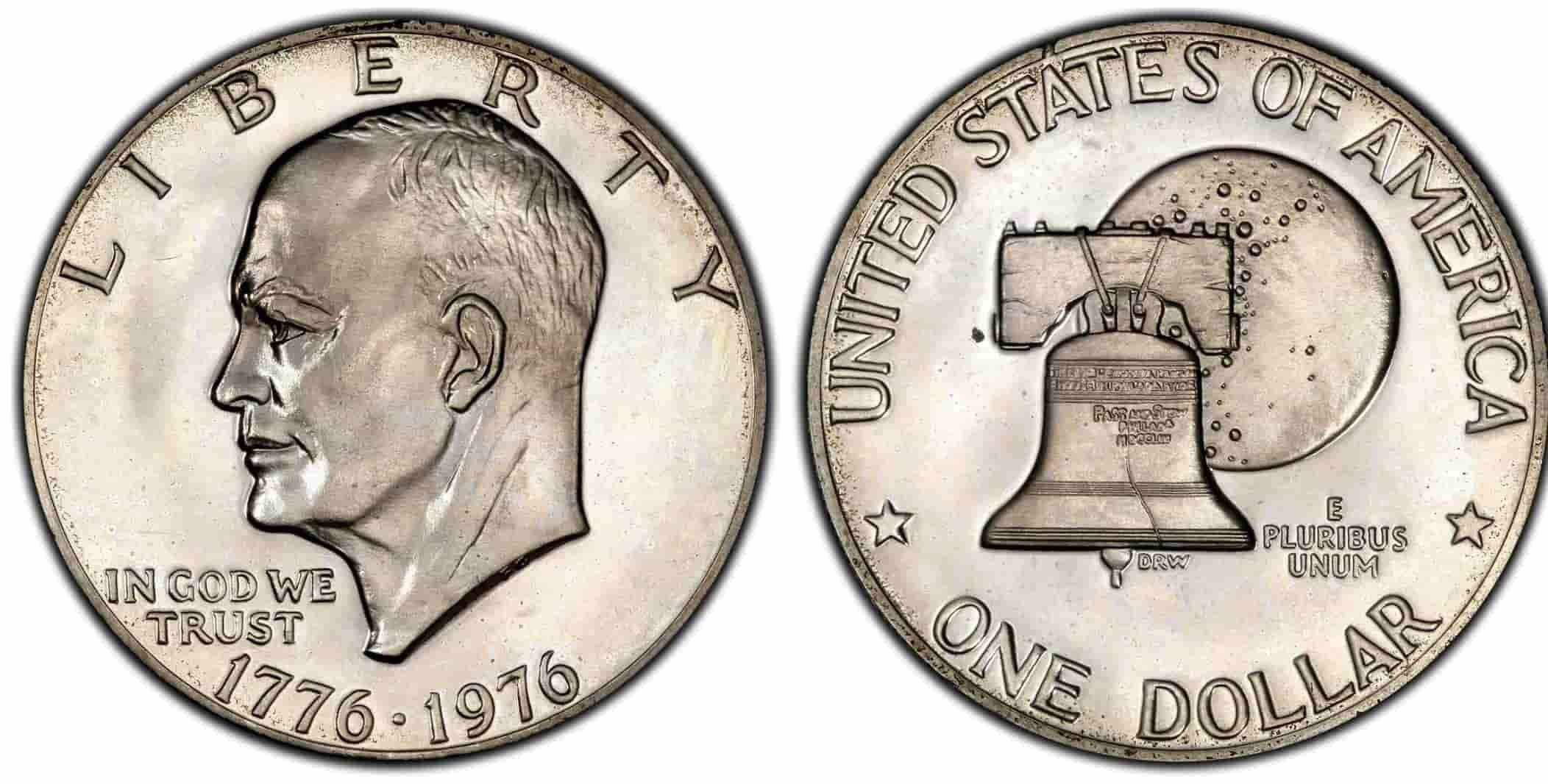1976 Eisenhower Dollar Value: Coins You Should Know About
Posted by Adamo - A certified ANA Professional Numismatist, Active member of ICTA, contributor to CoinWeek, Numismatic News, NGC and ANA on May 30th 2025
1976 Eisenhower Dollar Value: Coins You Should Know About
In 1976, Americans lined up at post offices, banks, and coin shops for something more than stamps or silver—they came for history. That year, the U.S. Mint released special coins to commemorate the nation’s Bicentennial. Among them, the Eisenhower Dollar stood out—not just for its size and patriotic design, but for what it symbolized: a connection between modern America and its founding ideals. Continue reading to learn more about 1976 Eisenhower Dollar Value.
For some, it was just pocket change. For others, it was a collectible piece of the 200th anniversary of independence. Today, those same coins are collectors’ favorites—some worth hundreds, even thousands of dollars.
But not all 1976 Eisenhower Dollars are created equal. This guide will walk you through the 1976 Eisenhower Dollar value, key coins you should know about, explain the difference between Type 1 and Type 2 varieties, and help you understand why collectors, both seasoned and new, are paying more attention than ever.
What makes a 1776-1976 eisenhower dollar rare?
For the clad business-strike issues, rarity is almost entirely a matter of top-end preservation and reverse variety. The Denver Mint struck about 21 million Bicentennial dollars, yet PCGS has certified only 19 coins of the scarcer Type 1 reverse at MS-67, with none finer; that is a survival rate of well under one in a million. Such conditional scarcity translates into real money: one of these MS-67 Type 1 pieces brought $9,600 at a Stack’s Bowers sale in November 2020, while lower-grade examples trade for only a few dollars above face value. PCGS
Composition adds a second axis of rarity. Roughly 4 million 40 %-silver Eisenhower dollars were struck exclusively for collectors at San Francisco, and although their mintage was larger than that of many classic-era commemoratives, perfection remains elusive: populations in PCGS PR70DCAM sit in the low double digits, and the record price for one of these flawless silver proofs is $6,900, whereas typical PR69 coins sell for under $30. The combination of precious-metal content, limited distribution outside mint sets, and the statistical difficulty of achieving either MS-67 for clad Type 1 dollars or PR70DCAM for silver proofs explains why a handful of 1776-1976 Eisenhower dollars command four-figure prices while the vast majority remain common.
Eisenhower Dollar Value - Quick-Reference Specs
1976 Eisenhower Dollar Value: Circulated copper-nickel “Ike” dollars from the Bicentennial typically trade for $1 – $3, but uncirculated pieces show sharp jumps—about $15 in MS-65, $35 in MS-66, and $1,000 + in scarce MS-67 for either Type 1 or Type 2. San-Francisco 40 % silver issues bring higher premiums: raw “Blue Pack” Uncirculated coins run $12 – $25, top-graded MS-69 pieces reach $200 +, and flawless “Brown Pack” silver proofs sell for $250 – $400. At the extreme end, the unique 1976-S No-S silver proof carries an estimated market value near $850,000, making it one of the most valuable modern U.S. coins.
| Variety | Composition | Mintage | Typical Raw Value (VF–AU) | Certified “Sweet-Spot” (MS/PR 65) | Registry-Level (MS/PR 67+) |
|---|---|---|---|---|---|
| 1776-1976 Type 1 (P) | Cu-Ni clad | 4,019,000 | $2–$5 | $50–$90 | $1,000 + |
| 1776-1976-D Type 1 | Cu-Ni clad | 21,048,710 | $2–$5 | $40–$80 | $9,600 auction record PCGS |
| 1776-1976 Type 2 (P) | Cu-Ni clad | 113,318,000 | Face value | $20–$40 | $10,800 record (MS 67+) PCGS |
| 1776-1976-D Type 2 | Cu-Ni clad | 82,179,564 | Face value | $20–$35 | $800–$1,500 |
| 1776-1976-S Type 1 & 2 Proofs | Cu-Ni clad | 2,845,450 / 4,149,730 | — | PR 69 DCAM $25–$60 | PR 70 DCAM $450 + |
| 1776-1976-S 40 % Silver Unc. (Blue Pack) | 40 % Ag | 11,000,000* | Melt + $4 | MS 65 $30–$45 | MS 69 $300 + |
| 1776-1976-S 40 % Silver Proof (Brown Pack) | 40 % Ag | 4,000,000* | — | PR 69 DCAM $40–$70 | PR 70 DCAM $275 + |
| 1976-S No-S Silver Proof | 40 % Ag | 1 known | — | — | PCGS Price Guide $850,000 PCGS |
1976-S No-S Silver Proof:
Why There Are Two Types of 1976 Eisenhower Dollars
Congress authorized the Ike dollar on 31 Dec 1970 in the Bank Holding Company Act Amendments, directing two metal formulas: a base-metal coin for circulation and a silver-collector version. CoinWeek
During 1975 the Mint found that the first Bicentennial hub (thick, blocky lettering) did not fill sharply in proofs or Mint-set strikes. Mint engravers recut the hub late in 1975, slimming the legends and sharpening the Liberty Bell crack:
-
Type 1 (1975 production) – Bold, flat lettering; seen only in 1975-dated Mint Sets or 1975-S proof sets.
-
Type 2 (1976 production) – Slim, serif-like letters; struck for all of 1976.
Both types carry the dual date 1776-1976. United States Mint
The Type 1 is slightly scarcer, especially in top grades, and highly sought after by type collectors who want both variants.
Silver vs Clad: Compositions and Why Two Different Planchets Exist
When you pick up a 1976 Eisenhower dollar you’re really holding one of two possible alloys—and that split wasn’t an accident. The first is the traditional 40% silver, minted only at the San Francisco Mint and bearing the S mint mark. The second is the cheaper copper-nickle, or clad, minted at both the Denver Mint, bearing the D mint mark, and the Philadelphia Mint, bearing no mint mark.
Why did the Mint bother with two planchets?
- Congressional compromise over silver.
In 1969–70 lawmakers sparred over whether an Eisenhower tribute coin should continue the tradition of a silver dollar or adopt the cheaper copper-nickel formula already used for dimes and quarters. The solution—written into the Bank Holding Company Act Amendments signed on December 31 1970—was a dual-track coin: base-metal pieces for circulation and limited 40 %-silver pieces for collectors. - Curbing the hoarding problem.
The Kennedy half-dollar’s high silver content caused the public to squirrel away rolls, starving commerce. Offering a “premium” silver version strictly by mail order let the Mint satisfy silver-coin traditionalists without draining everyday change of dollars.
Quick ways to tell which alloy you have
- Mint mark: only “S” dollars are 40 % silver (with a few extremely rare No-S proofs).
- Edge test: a pure silvery edge signals 40 % silver; a copper-orange stripe betrays the clad type.
- Weight: silver planchets average 24.59 g vs. 22.68 g for copper-nickel.
- Sound: a drop test yields a lower-pitched “ring” for silver.
Knowing why the two alloys exist not only clarifies history—it helps you decide which Ikes belong in your collection and how much premium they deserve in today’s market.
Composition, Weight & “Ring Test”
| Alloy | Weight | Visual Edge | Sound |
|---|---|---|---|
| Cu-Ni clad (.750 Cu, .250 Ni outer; Cu core) | 22.68 g | Copper stripe shows | Higher-pitched “clack” |
| 40 % Silver (outer .800 Ag, .200 Cu; inner .209 Ag) | 24.59 g | All silver-colored | Lower, sustained “ring” |
Specs are identical to other Eisenhower years.
Authoritative Mintage Table
PCGS research breaks down every Bicentennial Ike issue: PCGS
-
P mint: 4,019,000 (Type 1) 113,318,000 (Type 2)
-
D mint: 21,048,710 (Type 1) 82,179,564 (Type 2)
-
S mint clad proofs: 2,845,450 (Type 1) 4,149,730 (Type 2)
-
S mint 40 % silver: 11 million Unc. (Type 1), 4 million Proof (Type 2)
Market Highlights & Record Prices
| Coin | Grade | Record Price | Date / Venue |
|---|---|---|---|
| 1976-S No-S Silver Proof | PR 68 DCAM | Guide $850,000 | Private-treaty valuation PCGS |
| 1976-D Type 1 (clad) | MS 67 | $9,600 | Stack’s Bowers, Nov 2020 PCGS |
| 1976 Type 2 (P) | MS 67 + | $10,800 | Heritage, Jan 2024 PCGS |
| 1976-S Silver Proof | PR 70 DCAM | $4,080 | GreatCollections, Aug 2023 |
| 1976-S Silver Unc. | MS 69 | $3,120 | Heritage, Apr 2022 |
The dramatic spread between MS 66 and MS 67 is driven by low population reports—fewer than 350 PCGS-certified MS 67 examples for either type as of May 2025. PCGS
1976 Eisenhower Dollar Values to Watch For
Not every Ike is a jackpot, but these standout examples are worth noting:
- 1976-S No-S Proof Ike: One of the rarest modern U.S. coins, this 40% silver Ike should bear the S mint mark. Instead, this coin bears no mint mark, leading some to speculate that it may have been minted instead in Philadelphia. This coin sold for over $850,000 in a 2008 auction.
- MS67 Type 1 or Type 2 Clad Ikes: MS67s are valuable due to the low survival rate in this grade. PCGS reports values up to $1,200+.
- PR70 Silver Proofs (Brown Pack): Flawless examples can fetch $100–$250 depending on market trends.
To see real-time values, consider checking PCGS Price Guide or NGC Coin Explorer.
Grading Pointers for Bicentennial Ikes
-
Strike: Look at the bell clapper and Eisenhower’s hair. Weak detail usually caps the grade at MS 64–65.
-
Luster: Frosty cartwheel luster is essential for MS 66+.
-
Contact Marks: The coin’s 38 mm size means bag marks are common. A clean cheek is crucial for premium grades.
-
Proof Cameo: Deep-Cameo contrast (DCAM) commands 2×-3× regular proof prices—especially for clad Type 1 proofs, which are scarcer in 70.
Growing Your Eisenhower Dollar Collection with Confidence
The 1976 Eisenhower Dollar combines patriotic design, multiple alloys, and fascinating die-hub history. With mintages ranging from a single coin (the fabled No-S proof) to over 113 million, there is an entry point for every budget—and still plenty of room at the top for the next finest known discovery.
Building an Eisenhower Dollar collection is more than just a hunt for rare coins—it’s a journey through modern American history. Whether you’re searching for that elusive Type 1 in pristine condition or filling out a Dansco album with every year and mint mark, it’s important to buy from a trusted source.
That’s where Bullion Shark comes in. With a curated inventory of certified Eisenhower Dollars, silver packs, and hard-to-find errors, we help collectors of all levels build, expand, and protect their investments. Each coin is hand-selected for quality and authenticity—so you can collect with confidence.
A Dollar That Defied Expectations
The 1976 Eisenhower Dollar may not circulate today, but it continues to capture the attention of collectors, historians, and everyday Americans who remember the Bicentennial celebration. With two types, multiple metals, and more varieties than most people realize, this coin offers both historical value and collecting potential.
Whether you’re rediscovering coins from a family album or just now getting into numismatics, Eisenhower Dollars offer a perfect blend of accessibility and depth.
And with guidance from trusted names like Bullion Shark, your collection is already off to a strong start.




